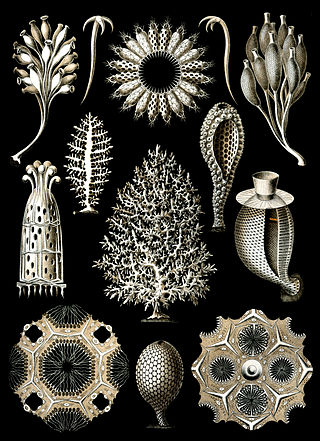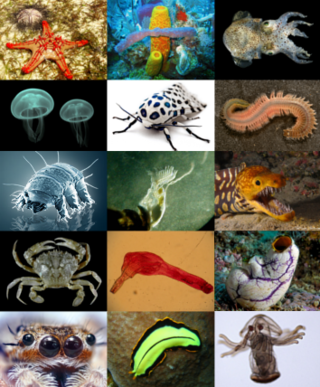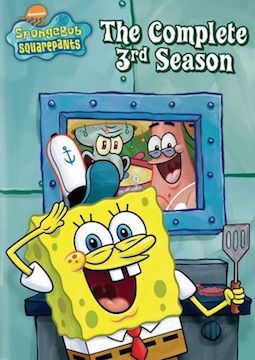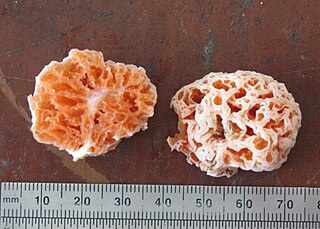
Sponges or sea sponges are primarily marine invertebrates of the metazoan phylum Porifera, a basal animal clade and a sister taxon of the diploblasts. They are sessile filter feeders that are bound to the seabed, and are one of the most ancient members of macrobenthos, with many historical species being important reef-building organisms.

Hexactinellid sponges are sponges with a skeleton made of four- and/or six-pointed siliceous spicules, often referred to as glass sponges. They are usually classified along with other sponges in the phylum Porifera, but some researchers consider them sufficiently distinct to deserve their own phylum, Symplasma. Some experts believe glass sponges are the longest-lived animals on earth; these scientists tentatively estimate a maximum age of up to 15,000 years.

SpongeBob SquarePants is a fictional character and the protagonist of Nickelodeon's eponymous American animated television series. Voiced by Tom Kenny, he is characterized by his optimism and childlike attitude. SpongeBob is a denizen of Bikini Bottom, where he regularly gets into absurd and humorous scenarios.

The calcareoussponges are members of the animal phylum Porifera, the cellular sponges. They are characterized by spicules made of calcium carbonate, in the form of high-magnesium calcite or aragonite. While the spicules in most species are triradiate, some species may possess two- or four-pointed spicules. Unlike other sponges, calcareans lack microscleres, tiny spicules which reinforce the flesh. In addition, their spicules develop from the outside-in, mineralizing within a hollow organic sheath.

Parrotfish are a group of fish species traditionally regarded as a family (Scaridae), but now often treated as a subfamily (Scarinae) or tribe (Scarini) of the wrasses (Labridae). With roughly 95 species, this group's largest species richness is in the Indo-Pacific. They are found in coral reefs, rocky coasts, and seagrass beds, and can play a significant role in bioerosion.

Stephen McDannell Hillenburg was an American animator, voice actor, and marine biology educator. Hillenburg was best known for creating the animated television series SpongeBob SquarePants for Nickelodeon in 1999. Serving as the showrunner for its first three seasons, and again from season nine until his death, the show has become the fifth-longest-running American animated series. He also provided the original voice of Patchy the Pirate's pet, Potty the Parrot.

Demosponges (Demospongiae) are the most diverse class in the phylum Porifera. They include greater than 90% of all species of sponges with nearly 8,800 species worldwide. They are sponges with a soft body that covers a hard, often massive skeleton made of calcium carbonate, either aragonite or calcite. They are predominantly leuconoid in structure. Their "skeletons" are made of spicules consisting of fibers of the protein spongin, the mineral silica, or both. Where spicules of silica are present, they have a different shape from those in the otherwise similar glass sponges. Some species, in particular from the Antarctic, obtain the silica for spicule building from the ingestion of siliceous diatoms.

SpongeBob SquarePants is an American animated television series created by marine science educator and animator Stephen Hillenburg for Nickelodeon. It first aired as a sneak peek after the 1999 Kids' Choice Awards on May 1, 1999, and officially premiered on July 17, 1999. It chronicles the adventures of SpongeBob SquarePants and his aquatic friends in the underwater city of Bikini Bottom.
Ascute is a genus of calcareous sponges. It contains two species, both found in Australia:

Cypraeidae, commonly named the cowries, is a taxonomic family of small to large sea snails. These are marine gastropod mollusks in the superfamily Cypraeoidea, the cowries and cowry allies.

Animals are multicellular, eukaryotic organisms in the biological kingdom Animalia. With few exceptions, animals consume organic material, breathe oxygen, have myocytes and are able to move, can reproduce sexually, and grow from a hollow sphere of cells, the blastula, during embryonic development. Animals form a clade, meaning that they arose from a single common ancestor. Over 1.5 million living animal species have been described, of which around 1.05 million are insects, over 85,000 are molluscs, and around 65,000 are vertebrates. It has been estimated there are as many as 7.77 million animal species on Earth. Animal body lengths range from 8.5 μm (0.00033 in) to 33.6 m (110 ft). They have complex ecologies and interactions with each other and their environments, forming intricate food webs. The scientific study of animals is known as zoology, and the study of animal behaviour is known as ethology.

The third season of the American animated television series SpongeBob SquarePants, created by Stephen Hillenburg, aired on Nickelodeon from October 5, 2001, to October 11, 2004, and consists of 20 half-hour episodes. The series chronicles the exploits and adventures of the title character and his various friends in the fictional underwater city of Bikini Bottom. The season was executive produced by series creator Hillenburg and supervising produced by Derek Drymon, who also acted as the showrunner. Hillenburg halted production on the show to work on the 2004 film adaptation of the series, The SpongeBob SquarePants Movie. After production on the film, Hillenburg resigned from the show as its showrunner, and appointed staff writer, Paul Tibbitt, to overtake the position. Season three was originally set to be the final season of the series, with the film acting as a series finale, but its success prevented the series from ending, leading to a fourth season.

Sponge reefs are reefs produced by sea sponges. All modern sponge reefs are formed by hexactinellid sponges, which have an endoskeleton made of silica spicules and are often referred to as "glass sponges", while historically the non-spiculed, calcite-skeletoned archaeocyathid and stromatoporoid sponges were the primary reef-builders.

Spicules are structural elements found in most sponges. The meshing of many spicules serves as the sponge's skeleton and thus it provides structural support and potentially defense against predators.
Ascute asconoides is a species of calcareous sponge found in Australia.

Patrick Star is a fictional character in the American animated television series SpongeBob SquarePants. He is voiced by actor Bill Fagerbakke and was created and designed by marine biologist and animator Stephen Hillenburg. He first appeared in the series' pilot episode "Help Wanted" on May 1, 1999. In addition to his supporting role on SpongeBob SquarePants, Patrick also serves as the main protagonist of The Patrick Star Show, which premiered in 2021.

Spongiforma squarepantsii is a species of fungus in the family Boletaceae, genus Spongiforma. Found in Malaysia, it was described as new to science in 2011. It produces sponge-like, rubbery orange fruit bodies that have a fruity or musky odour. The fruit bodies reach dimensions of 10 cm (3.9 in) wide by 7 cm (2.8 in) tall. Like a sponge, they will resume their original shape if water is squeezed out. The spores, produced on the surfaces of the hollows of the sponge, are almond-shaped with rough surfaces, and measure 10‑12.5 μm by 6‑7 μm. The name of the fungus derives from the Nickelodeon cartoon character SpongeBob SquarePants from the show of the same name. S. squarepantsii is one of two species in Spongiforma; it differs from S. thailandica in its color, odour, and spore structure.
Sea sponge aquaculture is the process of farming sea sponges under controlled conditions. It has been conducted in the world's oceans for centuries using a number of aquaculture techniques. There are many factors such as light, salinity, pH, dissolved oxygen and the accumulation of waste products that influence the growth rate of sponges. The benefits of sea sponge aquaculture are realised as a result of its ease of establishment, minimum infrastructure requirements and the potential to be used as a source of income for populations living in developing countries. Sea sponges are produced on a commercial scale to be used as bath sponges or to extract biologically active compounds which are found in certain sponge species. Techniques such as the rope and mesh bag method are used to culture sponges independently or within an integrated multi-trophic aquaculture system setting. One of the only true sustainable sea sponges cultivated in the world occur in the region of Micronesia, with a number of growing and production methods used to ensure and maintain the continued sustainability of these farmed species.
Sceptrulophora is an order of hexactinellid sponges. They are characterized by sceptrules, a type of microsclere with a single straight rod terminating at a bundle of spines or knobs. An anchor- or nail-shaped sceptrule is called a clavule. A fork-shaped sceptrule, ending at a few large tines, is called a scopule. A broom-shaped sceptrule, ending at many small bristles, is called a sarule.













